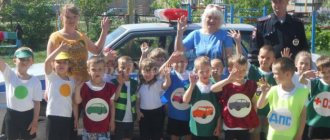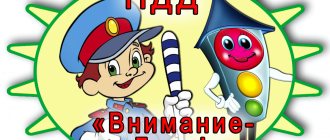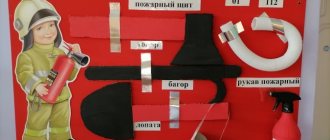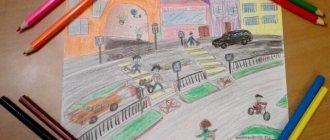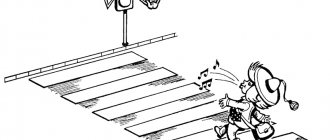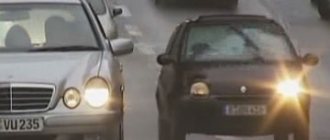“Traffic Safety Week, Fire Safety”
From 12.04 to 16.04 a project is taking place in our kindergarten
"Safety Week , Traffic Regulations, Fire Safety"
Teaching traffic rules in kindergarten is a vital necessity, so various activities on traffic rules are always relevant. After all, in kindergarten, a child not only masters the basic rules of the road, but also learns the most important rules of safe behavior on the road .
Forming a conscious and responsible attitude towards issues of personal safety and the safety of others teaches children the importance and necessity of knowledge about themselves: last name, first name, home address, telephone number, learn to dial the fire service number , and develop communication skills with the fire department on duty in an extreme situation.
Safe handling (matches, easily burning liquids, household items, household and electrical appliances). As well as informing and involving parents in preventive fire safety measures to ensure fire safety in our group .
Measures were taken to ensure safety in various life situations regarding fire safety and traffic rules with preschool children.
Discussions were held on the following topics: “Fire – friend and foe”, “What to do in dangerous situations?”, “Who to contact in case of fire”, “Firefighters and their work”, “Traffic lights and their friends, road signs”, “what is a pedestrian crossing"
Application “Traffic light and its friends, road signs” - preschoolers remembered traffic lights, got acquainted with new road signs “Parking”, “Food station”, “Danger”, etc. We learned the poem “Cheerful Traffic Light.”
Modeling theme “Fire Truck” - preschoolers reinforced familiar modeling techniques (rolling, unrolling, flattening, pressing); introduce a new technique (twisting)
Parents were consulted on the following topics:
“Educating a competent pedestrian”
Games with preschoolers at home!
Game “Move slower...”.
The driver stands on one side of the playing field, the players are at the other end, the driver turns away and says: “If you drive more quietly, you will go further, one, two, three, stop” and turns around, the players who are running towards the driver at this moment must freeze, the one who did not manage to stop in time returns to the starting line. The winner who is the first to reach the driver's territory becomes the driver himself. The whole point of interest lies in the fact that the phrase can be cut off in any way (an element of surprise is introduced), but the last word should still be “stop”, only after which the driver can turn around.
Attraction game “Attention, pedestrian!”
To play this game you need three wands, painted in three traffic light colors. The traffic controller shows the guys one of three rods alternately. Participants in the game take a step back when they see a red rod, stand when they see a yellow one, and step forward when they see a green one. The winner is the one who never made a mistake (if several children are playing).
Game "Guess where to go."
According to the commands “Left!”, “Right!” children turn left or right and continue moving, at the command “Around!” — rotate around its axis, at the command “Reverse!” — backing away like crayfish at the command “Back!” - turn around and “go” in the opposite direction.
Board and printed games.
In order to play these games with children, it is not necessary to buy expensive models in stores, because you can design any educational traffic rules game with your own hands. To do this, you need to stock up on colored paper, stationery cardboard, Whatman paper, paints, PVA glue and scissors. With the help of these items, every teacher or parent can glue and draw any road sign, traffic light, or car.
Game "Collect a sign".
Prepare road signs cut into pieces. Children collect and name the sign.
Game "Fold the traffic light."
Playing in teams. Children are divided into two teams of three. Each participant runs up to a “traffic light” (two rectangles with three circles) and lays out one colored circle. The team that displays the traffic light colors faster and correctly wins.
Even just one child would be interested in assembling a traffic light.
Game "Magic Circle"
Material: two cardboard disks connected in the center with a screw. On the bottom circle, along the edge, road sign designations are glued. A window is cut out on the outer circle at the edge, slightly larger than the road signs; pictures depicting road situations.
Progress of the game:
1st option: Children are shown a sign on a circle, they must name it and explain its meaning.
2nd option: The children are called a sign, they must find it on the circle and explain its meaning.
3rd option: Children are shown a picture depicting the situation on the road, they must find a road sign that needs to be placed here (“Bus stop”, “Pedestrian crossing”, “Railway crossing without a barrier”, etc.)
Educational games.
Game "Rules of Conduct".
Prepare cut-out pictures showing people in different situations. The teacher invites the children to look at them. Children look at these pictures, choose any one and tell them, remembering the rules of the road, what not to do and how to act.
This game helps to reinforce the rules of behavior with children; discuss various dangerous situations that may arise when playing in the courtyard or on the street; teach necessary precautions.
Game "Learning road signs."
Prepare a set of large and small cards with the same road signs.
Large ones are given to children, small ones remain with adults. The presenter takes turns showing cards with road signs, the child finds which large card it matches, takes the sign, puts it in the upper right corner and together they discuss what this sign is called and in what situations it is used. April 16, 2022 by admin
Thematic week on traffic rules “The ABC of Safety”
Thematic week dedicated to traffic rules in the preparatory group "Droplets"
"THE ABC OF SAFETY"
Educators:
Vorobyova M.V.
Turchenko O.V.
Explanatory note.
According to statistics, tens of thousands of traffic accidents involving children and adolescents occur annually on the roads of our country. That is why road traffic injuries remain a priority problem of society, requiring a solution with the general participation of teachers, parents and children.
Every adult should know the rules of the road for pedestrians and raise disciplined pedestrians in their children. After all, the rules of the road are the same for children and adults.
Therefore, the main task of parents and teachers is to clearly explain the rules to the child, and when choosing forms of education, to convey to children the meaning and the danger of non-compliance with the rules, without distorting their content.
It is important that when transitioning from kindergarten to school, the child can easily navigate the immediate spatial environment, be able to observe and correctly assess road situations, and have the skills to behave safely in these situations.
Target:
Systematize children's knowledge of traffic rules, instill skills of correct behavior on city streets, in the yard and public transport, observe and consciously implement traffic rules.
Tasks:
- cultivate a conscious attitude towards compliance with traffic rules;
- to develop a culture of behavior and road ethics in traffic conditions.
- develop motivation for safe behavior;
- develop in preschoolers the ability to navigate traffic situations;
- to develop skills of self-esteem, self-analysis of one’s behavior on the street and in transport.
- develop personal qualities - independence, responsibility, activity, accuracy.
- teach basic traffic rules;
- teach correct behavior on the streets, using the knowledge gained on this issue;
- to develop in preschoolers stable skills in observing and following traffic rules (traffic rules);
Monday.
Topic: Transport.
Conversation about transport, about the work of the driver.
Goal: to clarify children’s knowledge about vehicles, to replenish their active vocabulary with the names of cars, to talk about the work of a road driver.
Didactic game "Fourth odd"
Name an unnecessary road user: truck, house, ambulance, snowplow.
Name an extra means of transport: a car, a truck, a bus, a baby stroller.
Name a means of transport that is not public transport: bus, tram, truck, trolleybus.
Outdoor game: “Colored cars.”
Role-playing game "Car Showroom".
Goal: to teach children to write descriptions of cars, using the plan proposed by the teacher, to develop cultural communication skills, and to activate their vocabulary.
Examining and coloring images of various vehicles. Goal: to expand children’s understanding of the variety of vehicles, to consolidate the general concept of “transport”.
Game "You can't - you can"
Reading: Ryzhova E. “Transport of a big city.”
Tuesday.
Topic: "Traffic light".
Conversation: about the traffic light, its purpose, the meaning of the signals. Didactic game “Traffic Light” (attention)
Goal: to consolidate children’s ideas about the purpose of a traffic light, its signals, children’s ideas about colors (red, yellow, green).
“Memorizing the poem by R. Farhadi “At any intersection we are met by a traffic light.” Children compose stories “What I saw on the street when I went to kindergarten.”
Goal: to cultivate a positive attitude towards compliance with traffic rules, to develop memory; develop the ability to use the most common adjectives in speech.
gaming Independent activity: game “Let's build a street.”
Goal: to consolidate children’s knowledge about the roadway and traffic lights. Learn to “drive” cars without colliding with each other.
Outdoor game: “Stop, car!”
Purpose: to practice reaction speed, to consolidate the names of vehicles.
Plot-role-playing game “On the roads of the city” Purpose: to consolidate children’s knowledge about the rules of the road, to introduce them to the new role of a traffic controller, to cultivate self-control, patience, and attention on the road.
Design of a corner according to traffic regulations.
Goal: to teach the ability to select books and games on relevant topics, to develop thinking and an aesthetic sense when designing an exhibition.
Reading: A. Severny “Traffic Light”, B. Zhitkov “Traffic Light”
Wednesday.
Topic: “Pedestrians-passengers (intersection, underpass, pedestrian crossing, sidewalk and roadway)”
Conversation about rules of behavior in public transport.
Goal: to teach children to observe basic rules of behavior in public transport, to give an idea of why this is necessary.
Game “Go around traffic correctly”
Look carefully at the picture. Why do you think, when crossing the road, the bus and trolleybus go around behind, and the tram - in front? Follow the clues to find the correct cards. (Funny pictures and entertaining cards will help you get acquainted with the rules of the road in a playful way).
Word game.
Clap your hands when you hear a word related to a traffic light. Explain the choice of each word: three eyes, standing on the street, red light, standing at home, intersection, blue light, one leg, yellow light, pedestrian assistant.
Clap your hands when you hear a word that refers to a passenger. Explain your choice: bus, route, stop, road, swimming, reading, sleeping, ticket, conductor, plane flight, pedestrian, seat, cabin, bed.
Independent artistic activity: creating illustrations for the design of a little book about traffic rules as a gift to Dunno.
Goal: to develop in children the ability to convey their impressions received earlier, to cultivate independence in creating an image.
Outdoor game: “Pedestrians and cars” (walking in a given direction)
Goal: continue to teach children to act in accordance with a signal and develop attention.
Role-playing game “Bus”, “Chauffeurs”
Reading: V. Timofeev “For pedestrians.”
Guessing riddles.
Thursday.
Topic: “Road signs.”
Conversation “Your helpers on the road”
Goal: to give children an idea that there are prohibitory and permissive signs, to familiarize them with the signs “Pedestrian crossing”, “Children”, “Public transport stop”, etc. that are understandable to children.
Lotto "Road Signs"
Goal: consolidate knowledge about road signs and their names; develop attention and memory.
Game "Find out the road sign"
Large and small colored cards are mixed on the table. Large cards have colored outlines of road signs. On small cards there are missing fragments of signs. The child chooses any large card. He must then select and overlay each image of the large card with a small card to create an existing road sign.
Artistic creativity: drawing.
Topic: “Create a road sign.”
Goal: to convey to children that every sign warns road users about something, to develop children’s imagination.
Outdoor game: “Bus”
Goal: to consolidate the ability to move in pairs, in coordination, on a signal
Outdoor game “Find your place” (with signs, with traffic lights)
Role-playing game “On the streets of the city” and “Outside the city”
Goal: to strengthen children’s skills of safe behavior on the street, to develop the ability to use buildings made of building material in play. Attach road signs - railway crossing with a barrier, and without a barrier.
Guessing riddles according to traffic rules.
Friday. Final lesson. "UNKNOW IN THE CITY"
Program content:
1. Consolidate children’s knowledge: about road markings, types of pedestrian crossings, warning actions (road works, children): prohibiting actions (pedestrian traffic is prohibited, bicycle traffic is prohibited); information and signposts (bus stop, tram stop). 2. To develop monologue (story based on a picture) and dialogic (children’s answers with common sentences) speech of children, expressiveness of speech. 3. Foster a desire to comply with traffic rules.
Activating the dictionary:
Roadway, dividing strip, sidewalk, passengers, pedestrians, underground passage, zebra crossing, public transport, special transport.
Preliminary work:
Conversation about the city, observation of transport. Examination of the picture, didactic games and role-playing games (driver and pedestrians) according to traffic rules. Learning poetry. Reading works on the topic of traffic rules.
Lesson equipment:
Painting “Street of our city”, pictures depicting vehicles. Didactic game “Assemble a traffic light”, road signs, audio recording.
Progress of the lesson:
Educator
: Guys, today we will remember the rules of the road. — Tell me, what is the name of our city? — Tell me, what is there in our city? (Streets, squares, parks, schools, kindergartens, shops). — Guys, our city is big and there are many streets and avenues. Which ones do you know?
(Knock on the door, Dunno appears).
Educator
: Guys, a guest has arrived from a fabulous flower city. Do you recognize our guest? Who is this?.. Dunno is embarrassed and upset about something.
Dunno
: Finding myself in a big and noisy city, I was confused, I was lost... Not knowing the traffic lights, I almost got hit by a car! There are cars and trams all around, then suddenly a bus is on the way. To be honest, I don’t know where to cross the road.
Guys, help me and, if possible, tell me how to cross the road so as not to get run over by a tram!
Educator
: Our guys are already familiar with the most important rules of the road. They, Dunno, will tell you and show you how to behave on the streets of a big city. Let's help Dunno?...Sit down and listen. - Let's look at this picture.
1. child
: (shows in the picture) The picture shows a street in our city. The roadway of the street is divided by a dividing strip. Cars do not cross a solid dividing line; only a broken line can be crossed. In these places, cars change lanes from one part of the road to another.
2. child:
(shows in the picture) Pedestrians walk along the sidewalks.
You can cross the street at a zebra crossing or through an underground passage. In front of the underground passage there is a sign indicating the underground passage. "Zebra" S. Mikhalkov.
This should be clear to everyone!
Even to those who go to nurseries To everyone who lives in the city: Transitions are not risky Only where Zebras have white stripes. And on the “Transition” arrow 3. child:
(points in the picture) The picture shows a traffic light.
The red light is on - there is no passage. After the red light, the yellow light turns on and all drivers get ready to continue on their way. The vehicles will start moving when the light turns green. “Traffic light”
At the crossroads of two roads Stands in heat, hail, and ice An unusual guard guards the peace here. He has three eyes. Each one gives us a message. If the red light is on, the path is closed to traffic. Don't let the driver move. Yield to the pedestrian. The second yellow light is on, telling us to get ready. And the green light is on - there is no way for pedestrians. This light gives a call: All drivers - go ahead! This is our hero, a kind, honest guard!
Outdoor game “Assemble a traffic light”
The teacher suggests dividing into two teams. A girls team and a boys team. Whose team will be the fastest to assemble a traffic light from parts?
4. child
(shows in the picture) The picture shows: passenger, cargo, public and special (fire truck, ambulance, police car) transport.
This sign indicates that travel is permitted straight and to the right. Educator:
Do you think the residents of our city walk everywhere or do we have public transport?.. What kind of public transport runs in our city?.. (tram, bus, gazelle) Listen to the riddle:
A house is walking down the street, taking everyone to work, not on thin chicken legs, but in rubber boots (Bus)
Who does the bus transport?.. Where do people wait for its arrival?.. What are the names of those who travel on the bus?.. And when people walk, what are they called?.. Didactic game “Modes of Transport”
Educator:
Each of you has a picture of a vehicle under your chair. Take and carefully look at your pictures and think about what type of transport what is depicted there refers to. Come to me, those who have a picture of a passenger mode of transport. Name them. Now who has a cargo mode of transport? Name them. Who has a special type of transport? Name them.
Outdoor game "Cars on the city streets"
Children (cars) walk in a group (in a circle) following traffic light signs. Red light - they stand still, yellow - they walk in place, green - they walk around the group.
Educator:
(There are road signs at the edges of the group.) Now each of you, in turn, will go up to any sign, name and explain what kind of road sign it is. Well, Dunno, you remember what the kids told you. Do you already know how to behave correctly on the street? Dunno: Yes, I remember what you told me today in class. I even remembered riddles about traffic rules. Guess!..
The red carriage runs along the rails, it quickly takes everyone where they need to go. Children like its jingling sound. So what do we wear around the city? (Tram)
Yellow on top, blue on the bottom, a star on his chest, and overhead lines of wires stretched above him. (Trolleybus)
To help you pass the dangerous path, It burns day and night, Green, yellow, red. (Traffic light)
This is a sign of this kind - It guards the pedestrian. We move on with the doll together. We're on our way to this place. (Crosswalk)
You know so much and know how to apply your knowledge, I want to give you coloring books “Types of Transport” (gives). Goodbye! (leaves)
Educator:
Guys, what did you like most about our lesson? (children’s answers with analysis of actions in the lesson)
Working with parents.
Setting up a traffic rules corner in the locker room.
Consultation on the topic: “Children’s car seat.”
It is difficult to argue that for parents there is nothing more important than the safety of their child. And staying safe on the road is doubly important. Therefore, having a car restraint system (in other words, a car seat) in your car is extremely important and saving in this case is simply unacceptable and sometimes even fatal. Choosing the right and high-quality child car seat is not very easy, but if you know a few simple rules, it will become much easier to decide. Firstly, of course, when choosing a chair, the age of your baby is taken into account. There are several categories of these restraints intended for children of different ages: from 0 to 12 years (according to the current law, drivers are required to transport children in special restraints up to this age) A group of car seats designed for the youngest passengers aged 0 to 1 year , designed for a weight of no more than 12-13 kg. Such models can take a position not only half-sitting, but also lying down. For safety reasons, they are installed against the movement of the car. You can, as an option, consider restraint devices such as a car seat. They are installed along the back seat of the car and are intended for babies up to six months. But when choosing this restraint device, you should remember that its safety is relative. Most enterprises producing infant carriers have abandoned their production, since the possibility of injury to a child in a seat is very high, which has been proven by numerous tests. The devices in the next group are intended for children aged 1 to 4 years. In this case, the minimum weight of the child is 9 kg, and the maximum should not exceed 18 kg. The third group of seats is convenient because it can carry a child, both a newborn and a fairly adult one (up to 4 years old), that is, you don’t have to think about replacing the child restraint once again, and also allow you to save a certain amount of money. It can be installed both against the direction of the car and in the direction of the car, which depends on the age of your child. The two remaining groups of seats are intended for children aged 3 to 7 years (about 15-25 kg) and from 6 to 12 years (22-36 kg). They are installed in the direction of travel of the car. There are also car seats that combine qualities that allow them to be used for both a one-year-old baby and a twelve-year-old child. The fact is that they are equipped with adjustable straps, a high back and side fastenings, so they can be easily adjusted to suit the age of your child. By the way, make sure that your car restraint system is certified. Such devices will help you and your child not only in the event of an accident. Be careful and do not forget about the safety of your children.
